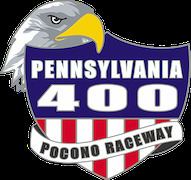First race 1974 (1974) Distance 643,738 m | Most wins (driver) Bill Elliott (4) Venue Pocono Raceway | |
 | ||
Location Long Pond, Pennsylvania, United States Laps 160 (Stage 1: 50
Stage 2: 50
Stage 3: 60) Previous names Pennsylvania 500 (1971–1972, 1974, 1997–2007)
Acme 500 (1973)
Purolator 500 (1974–1976)
Coca-Cola 500 (1977–1980)
Mountain Dew 500 (1981–1982)
Like Cola 500 (1983–1984)
Summer 500 (1985–1987)
AC Spark Plug 500 (1988–1990)
Miller Genuine Draft 500 (1991–1995)
Miller 500 (1996)
Sunoco Red Cross Pennsylvania 500 (2008–2010)
Good Sam RV Insurance 500 (2011)
Pennsylvania 400 (2012, 2016–)
Gobowling.com 400 (2013–2014)
Windows 10 400 (2015) Most wins (team) Hendrick Motorsports
Penske Racing (6) Instances 2016 Pennsylvania 400, 2012 Pennsylvania 400, 2011 Good Sam RV Insurance, 2009 Sunoco Red Cros, 2008 Sunoco Red Cros | ||
Nascar sprint cup series 2016 pennsylvania 400 chase elliott joey logano crash
The Pennsylvania 400 is the second of two Monster Energy NASCAR Cup Series stock car races held at the Pocono Raceway in Long Pond, Pennsylvania, the other being the Axalta "We Paint Winners" 400. Starting in 2007, the race was moved from its traditional July date into August, swapping dates with the Brickyard 400.
Contents
- Nascar sprint cup series 2016 pennsylvania 400 chase elliott joey logano crash
- Jeff gordon career win 86 2012 pennsylvania 400 finish hd
- Notable moments
- Notes
- Television broadcasters
- References
In 2008, Sunoco, the official NASCAR fuel supplier, based in Pennsylvania, and the Philadelphia region of the American Red Cross, agreed to sponsorship of the race and charity events to benefit the American Red Cross South Pennsylvania-Philadelphia region. It marked the first time since 1996 that the event carried a title sponsor. Camping World took over title sponsorship of sponsorship through its Good Sam Club in 2011. The race was a 500-mile (800 km), 200 lap event from its inception in 1974, through the 2011 race. On August 10, 2011, it was announced that both Pocono races would be shortened to 400 miles (640 km), beginning in 2012.
The Bowling Proprietors' Association of America, through its marketing arm Strike Ten Entertainment, signed a two-year contract with the circuit to be entitlement sponsor starting in 2013.
Jeff gordon career win 86 2012 pennsylvania 400 finish hd
Notable moments
Notes
Television broadcasters
*: Benny Parsons was scheduled to be the color commentator, but was to drive an Oldsmobile in the 1986 Summer 500. Jerry Punch replaced Parsons during the SETN broadcast until he retired from the race.
